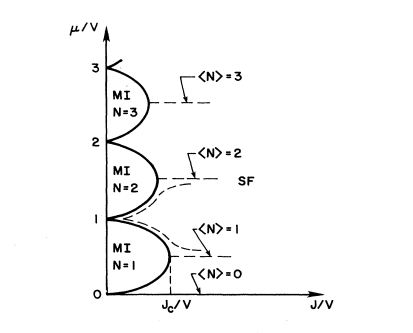Bose Hubbard model: Difference between revisions
JoeBelarge (talk | contribs) No edit summary |
JoeBelarge (talk | contribs) No edit summary |
||
| Line 16: | Line 16: | ||
The first experimental evidence in support of the BHM was observed in 2002. Greiner and collaborators (Nature paper, need to cite) created a <math>^{87}Rb</math> Bose-Einstein condensate that was spherically symmetric, and magnetically trapped. To form the three dimensional lattice potential three optical standing waves were set up perpendicular to eachother with the crossing point of the three beams positioned at the center of the condensate. The magnetically trapped condensate was then transferred to the optical lattice by slowly increasing the beam intensity. By increasing slowly it was ensured that the atoms stayed in the many body ground state. When the beams reached full intensity the condensate was spread over more than 150,000 lattice sites with an average of 2.5 atoms per lattice cite in the center of the condenstate | The first experimental evidence in support of the BHM was observed in 2002. Greiner and collaborators (Nature paper, need to cite) created a <math>^{87}Rb</math> Bose-Einstein condensate that was spherically symmetric, and magnetically trapped. To form the three dimensional lattice potential three optical standing waves were set up perpendicular to eachother with the crossing point of the three beams positioned at the center of the condensate. The magnetically trapped condensate was then transferred to the optical lattice by slowly increasing the beam intensity. By increasing slowly it was ensured that the atoms stayed in the many body ground state. When the beams reached full intensity the condensate was spread over more than 150,000 lattice sites with an average of 2.5 atoms per lattice cite in the center of the condenstate | ||
The potential depth was modified, and by doing this the superfluid phase, and Mott insulator phase were able to be observed. The depth was modified by adjusting the trapping frequencies. | |||
=== SuperFluid Phase === | |||
==References== | ==References== | ||
<references/> | <references/> | ||
Revision as of 13:11, 14 December 2012
Introduction
The Bose-Hubbard Model (BHM) was first studied in detail in 1989 by Fisher et al. (need to cite phys rev b article by fisher et al.) They studied a three dimensional Bose gas in several different types of systems, including the most simple case at zero temperature. --> This is just an idea, I havent finished it yet, and dont know if it is necessary so let me know what you guys think about it.
Hamiltonian
Solving the Hamiltonian
Phase Transition
Experimental Evidence of BHM
First Experiment (Nature Paper)
The first experimental evidence in support of the BHM was observed in 2002. Greiner and collaborators (Nature paper, need to cite) created a Bose-Einstein condensate that was spherically symmetric, and magnetically trapped. To form the three dimensional lattice potential three optical standing waves were set up perpendicular to eachother with the crossing point of the three beams positioned at the center of the condensate. The magnetically trapped condensate was then transferred to the optical lattice by slowly increasing the beam intensity. By increasing slowly it was ensured that the atoms stayed in the many body ground state. When the beams reached full intensity the condensate was spread over more than 150,000 lattice sites with an average of 2.5 atoms per lattice cite in the center of the condenstate
The potential depth was modified, and by doing this the superfluid phase, and Mott insulator phase were able to be observed. The depth was modified by adjusting the trapping frequencies.

